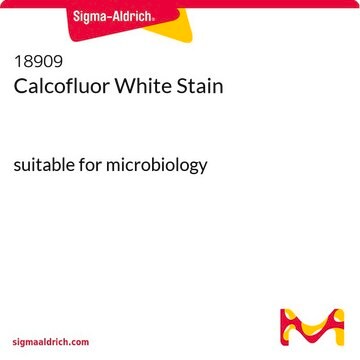The form of the dye, whether as a powder or crystals, should not impact the process of reconstituting Nile Red or most other dyes. For product 72485, both the powder and crystal forms have the same solubility specification. Therefore, either form is acceptable. It's advisable to first use the solvent recommended in a published procedure if following one.
72485
Nile Red
for microscopy
Synonyme(s) :
Nile Blue A Oxazone
About This Item
Produits recommandés
Qualité
for microscopy
Niveau de qualité
Forme
crystals
Pf
203-205 °C (lit.)
λmax
553 nm
Chaîne SMILES
CCN(CC)c1ccc2N=C3C(Oc2c1)=CC(=O)c4ccccc34
InChI
1S/C20H18N2O2/c1-3-22(4-2)13-9-10-16-18(11-13)24-19-12-17(23)14-7-5-6-8-15(14)20(19)21-16/h5-12H,3-4H2,1-2H3
Clé InChI
VOFUROIFQGPCGE-UHFFFAOYSA-N
Vous recherchez des produits similaires ? Visite Guide de comparaison des produits
Description générale
Code de la classe de stockage
11 - Combustible Solids
Classe de danger pour l'eau (WGK)
WGK 3
Point d'éclair (°F)
Not applicable
Point d'éclair (°C)
Not applicable
Équipement de protection individuelle
Eyeshields, Gloves, type N95 (US)
Faites votre choix parmi les versions les plus récentes :
Déjà en possession de ce produit ?
Retrouvez la documentation relative aux produits que vous avez récemment achetés dans la Bibliothèque de documents.
Les clients ont également consulté
-
Can the crystal form of Nile Red be used in the same way as the powder form, specifically in terms of using acetone to dissolve and create working solutions?
1 answer-
Helpful?
-
-
How can Nile Red be prepared for staining nanoparticles, and what is the process for staining different particle sizes?
1 answer-
Fat or lipid dyes, such as the Sudan and Nile series, typically stain by dissolving the dye into a solvent with low solubility, followed by further dilution with water for use in most staining protocols. When the dye encounters a fat or lipid, it moves from the solvent with low solubility to the solvent with higher solubility. Nile Red is soluble in DMF, DMSO, heptane, xylene, 1% in acetone, and 0.1% in ethanol. There is no specific procedures for staining nanoparticles. However, if the nanoparticles contain a fat or lipid component, Nile Red is expected to work. As for the particle size in solution, there is no available information.
Helpful?
-
Active Filters
Notre équipe de scientifiques dispose d'une expérience dans tous les secteurs de la recherche, notamment en sciences de la vie, science des matériaux, synthèse chimique, chromatographie, analyse et dans de nombreux autres domaines..
Contacter notre Service technique









